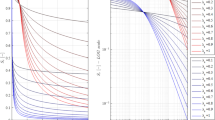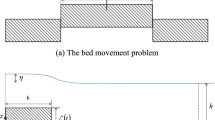Abstract
The propagation and hydrodynamic processes of lock-exchange gravity current through vegetation regions were investigated experimentally. Experimental results show that the presence of vegetation can prominently advance the transition position of the gravity current from the slumping phase to the self-similar phase. The process of two-heads propagation can be divided into three stages: the coordinated advance stage (vegetation height controls), the overtaking stage (entrainment process and vegetation friction dominate), and the merge stage (vegetation density controls). After an adjustment period, the bulk slope angle \(\beta_b\) of the triangular gravity current converges to a constant terminal value. A modified empirical equation is fitted to better meet the stable convergence of the terminal bulk slope angle \(\beta_b\). The mixing layer formed at the transverse boundary between the vegetation and no-vegetation part can promote fluid entrainment. For the submerged vegetation, the gravity current flows over a new “wall boundary”, i.e. the top of the vegetation region, and causes the negative vorticity. The changes in the vorticity field indicate the presence of vegetation can significantly affect the internal flow-field structure of gravity currents.
Article Highlights
-
(1)
The process of two-heads propagation for gravity current flowing within submerged vegetation can be divided into three stages: the coordinated advance stage (vegetation height controls), the overtaking stage (entrainment process and vegetation friction dominate), and the merge stage (vegetation density controls).
-
(2)
A modified empirical equation is fitted to better meet the stable convergence of the terminal slope angle \(\beta_b\) for lock-exchange gravity current within vegetation.
-
(3)
The vegetation exerts resistance on the gravity current and suppresses the K-H instability at the interface, which weakens the entrainment process, but the mixing layer formed at the transverse boundary of the vegetation region promotes fluid entrainment.













Similar content being viewed by others
References
Simpson JE (1999) Gravity currents: in the environment and the laboratory. Cambridge University Press, Cambridge, U.K.
Nogueira HIS, Adduce C, Alves E (2013) Analysis of lock-exchange gravity currents over smooth and rough beds. J Hydraul Res 51(4):417–431
Kneller B, Buckee C (2000) The structure and fluid mechanics of turbidity currents: a review of some recent studies and their geological implications. Sedimentology 47(s1):33–65
Tokyay T, Constantinescu G, Meiburg E (2014) Lock-exchange gravity currents with a low volume of release propagating over an array of obstacles. J Geophys Res C Oceans 119:2752–2768
Özgökmen TM, Fischer PF (2008) On the role of bottom roughness in overflows. Ocean Model 20(4):336–361
Adduce C, Sciortino G, Proietti S (2012) Gravity currents produced by lock-exchanges: experiments and simulations with a two-layer shallow-water model with entrainment. J Hydraul Eng 138(2):111–121
Shin JO, Dalziel SB, Linden PF (2004) Gravity currents produced by lock exchange. J Fluid Mech 521(21):1–34
De Falco MC, Ottolenghi L, Adduce C (2020) Dynamics of gravity currents flowing up a slope and implications for entrainment. J Hydraul Eng 146(4):04020011
De Falco MC, Adduce C, Negretti ME, Hopfinger EJ (2021) On the dynamics of quasi-steady gravity currents flowing up a slope. Adv Water Res 147:103791
Wilson RI, Friedrich H, Stevens C (2018) Flow structure of unconfined turbidity currents interacting with an obstacle. Environ Fluid Mech 18(6):1571–1594
Wilson RI, Friedrich H, Stevens C (2019) Quantifying propagation characteristics of unconfined turbidity currents interacting with an obstacle within the slumping regime. J Hydraul Res 57(4):498–516
Bhaganagar K (2014) Direct numerical simulation of lock-exchange density currents over the rough wall in the slumping phase. J Hydraul Res 52(3):386–398
Constantinescu G (2014) LES of lock-exchange compositional gravity currents: a brief review of some recent results. Environ Fluid Mech 14(2):295–317
Zhu JB, Lee CB, Chen GQ (2006) PIV observation of the instantaneous velocity structure of lock-release gravity currents in the slumping phase. Commun Nonlinear Sci Numer Simul 11(2):262–270
Samothrakis P, Cotel AJ (2006) Propagation of a gravity current in a two-layer stratified environment. J Geophys Res Oceans. 111(C1)
Martin JE, Marcelo HG (2009) Combined PIV/PLIF measurements of a steady density current front. Exp Fluids 46(2):265–276
Ooi SK, Constantinescu G, Weber L (2009) Numerical simulations of lock-exchange compositional gravity current. J Fluid Mech 635(35):361–388
Lombardi V, Adduce C, La Rocca M (2018) Unconfined lock-exchange gravity currents with variable lock width: laboratory experiments and shallow-water simulations. J Hydraul Res. pp 1–13
Huang H, Imran J, Pirmez C (2008) Numerical study of turbidity currents with sudden-release and sustained-inflow mechanisms. J Hydraul Eng 134(9):1199–1209
Guo Y, Zhang Z, Shi B (2014) Numerical simulation of gravity current descending a slope into a linearly stratified environment. J Hydraul Eng 140(12):04014061
Inghilesi R, Adduce C, Lombardi V, Roman F, Armenio V (2018) Axisymmetric three-dimensional gravity currents generated by lock exchange. J Fluid Mech 851:507–544
Pelmard J, Norris S, Friedrich H (2018) LES grid resolution requirements for the modeling of gravity currents. Comput Fluids 174:256–270
Pelmard J, Norris S, Friedrich H (2020) Statistical characterization of turbulence for an unsteady gravity current. J Fluid Mech 901:A7
Härtel C, Meiburg E, Necker F (2000) Analysis and direct numerical simulation of the flow at a gravity-current head. Part 1. Flow topology and front speed for slip and no-slip boundaries. J Fluid Mech 418:189–212
Necker F, Härtel C, Kleiser L, Meiburg E (2002) High-resolution simulations of particle-driven gravity currents. Int J Multiph Flow 28(2):279–300
Nasr-Azadani MM, Meiburg E, Kneller B (2018) Mixing dynamics of turbidity currents interacting with complex seafloor topography. Environ Fluid Mech 18(1):201–223
Meiburg E, Radhakrishnan S, Nasr-Azadani MM (2015) Modeling gravity and turbidity currents: computational approaches and challenges. Appl Mech Rev 67(4):040802
Liu D, Diplas P, Fairbanks JD (2008) An experimental study of flow through rigid vegetation. Journal of Geophysical Research Earth Surface. 113(F4).
Li CW, Zhang ML (2010) Numerical modeling of shallow water flows around arrays of emerged cylinders. J Hydro-environ Res 4(2):115–121
Tanino Y, Nepf HM, Kulis PS (2005) Gravity currents in aquatic canopies. Water Resour Res 41(12):1–9
Tanino Y, Nepf HM (2008) Laboratory investigation of mean drag in a random array of rigid, emergent cylinders. J Hydraul Eng 134(1):34–41
Zhang XY, Nepf HM (2008) Density-driven exchange flow between open water and an aquatic canopy. Water Resour Res 44(8):1–7
Ho H, Lin Y (2015) Gravity currents over a rigid and emergent vegetated slope. Adv Water Res 76:72–80
Gu Z, Ho H, Wang Z, Lin Y (2018) Laboratory studies on nearshore density-driven exchange flow over a partly vegetated slope. Water 10(8):1073
Ottolenghi L, Cenedese C, Adduce C (2017) Entrainment in a dense current flowing down a rough sloping bottom in a rotating fluid. J Phys Oceanogr 47(3):485–498
Cenedese C, Nokes R, Hyatt J (2016) Lock-exchange gravity currents over rough bottoms. Environ Fluid Mech 18(1):59–73
Soler M, Colomer J, Serra T (2017) Sediment deposition from turbidity currents in simulated aquatic vegetation canopies. Sedimentology 64(4):1132–1146
Ozan AY, Constantinescu G, Hogg AJ (2015) Lock-exchange gravity currents propagating in a channel containing an array of obstacles. J Fluid Mech 765:544–575
Zhou J, Cenedese C, Williams T, Ball M, Venayagamoorthy SK, Nokes RI (2017) On the propagation of gravity currents over and through a submerged array of circular cylinders. J Fluid Mech 831:394–417
Hallberg R (2000) Time Integration of diaconal diffusion and Richardson number dependent mixing in isopycnal coordinate ocean models. Mon Weather Rev 128(5):1402–1419
Tanino Y, Nepf HM (2009) Laboratory investigation of lateral dispersion within dense arrays of randomly distributed cylinders at transitional Reynolds number. Phys Fluids 21(4):339–480
Pujol D, Serra T, Colomer J (2013) Flow structure in canopy models dominated by progressive waves. J Hydrol 486(8):281–292
Testik FY, Yilmaz NA (2015) Anatomy and propagation dynamics of continuous-flux release bottom gravity currents through emergent aquatic vegetation. Phys Fluids 27(5):112–130
Thielicke W, Stamhuis E (2014) PIVlab-towards user-friendly, affordable and accurate digital particle image velocimetry in MATLAB. J Open Res Softw 2(1):1–10
He Z, Zhao L, Lin T, Hu P, Lv Y, Lin Y (2016) Experiments on gravity currents down a ramp in unstratified and linearly stratified saltwater environments. Sci Sin Technol 46(6):570–582
Simpson JE (1982) Gravity current in the laboratory, atmosphere, and ocean. Annu Rev Fluid Mech 14(1):213–234
Benjamin T (1968) Gravity currents and related phenomena. J Fluid Mech 31(2):209–248
Dai A (2017) Experiments on two-layer density-stratified inertial gravity currents. Phys Rev Fluids 2(7):073802
Rottman JW, Simpson JE (1983) Gravity currents produced by instantaneous release of a heavy fluid in a rectangular channel. J Fluid Mech 135(21):95–110
Linden P (2012) Gravity currents-theory and laboratory experiment. Cambridge University Press, Cambridge, U.K.
Jacobson MR, Testik FY (2014) Turbulent entrainment into fluid mud gravity currents. Environ Fluid Mech 14(2):541–563
Morton BR, Taylor G, Turner JS (1956) Turbulent gravitational convection from maintained and instantaneous sources. Proc R Soc Math Phys Eng Sci 234(1196):125–128
Acknowledgements
This work was supported by National Key Research and Development Project of China [grant number 2017YFC0405205], Natural Science Foundation of Zhejiang Province of China [grant number LY20A020009], and Fundamental Research Funds for the Central Universities [grant number 2020QNA4038]. The author thanks the laboratory instrument of Ocean College of Zhejiang University for support.
Author information
Authors and Affiliations
Corresponding author
Additional information
Publisher's Note
Springer Nature remains neutral with regard to jurisdictional claims in published maps and institutional affiliations.
Rights and permissions
About this article
Cite this article
Han, D., Xiong, J., Xie, X. et al. Effects of emergent and submerged rigid vegetation configurations on gravity current dynamics. Environ Fluid Mech 21, 1165–1187 (2021). https://doi.org/10.1007/s10652-021-09814-5
Received:
Accepted:
Published:
Issue Date:
DOI: https://doi.org/10.1007/s10652-021-09814-5




